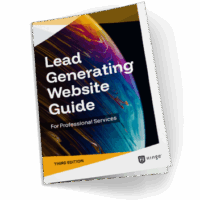People read words differently online than they do when reading printed materials. For example, instead of reading left to right and line-by-line, website users scan the page looking for phrases or keywords that catch their attention.
As web users, why do we do this? Usually, we’re on a mission to answer a question we have. We don’t have the time (or patience) to read more than necessary. And frankly, we also know that we don’t have to.
Most of the time, we’re not interested in the entire page of content and are only looking for the sections that pertain to our interests. This is most relevant to informational sections of your website such as your services pages, “about us,” industries you serve, and contact pages. This is less relevant for longer-form content like articles, white papers, or blog posts.
In fact, an online study by Jakob Nielsen conducted some years ago but still holds true about reading behavior found that, on average, web users read just 28% of the words on a page.
So, what can professional services firms do to make their website copy user-friendly? Most importantly, format web copy to support user scanning. If we know users spend most of their time scanning text in search of something, then how you format your text can make a big difference.
Here are seven best practices to keep in mind:
1. Use plenty of headings.
Well-written headlines act as the informal outline of a page. Creating headings that summarize the content of that paragraph(s) lets the user understand what that section is about before deciding whether or not they want to read it.
2. Use bullet points.
Bulleted lists allow for optimal readability and allow users to easily understand and store that information. Almost any series of items separated with commas has potential to be formatted into a bulleted list.
3. Keep paragraphs short.
Long paragraphs are dense and hard to scan. If you review a long paragraph, you can almost always find a place where you could break it up in to two paragraphs. This makes the information easier for the user to digest.
4. Frontload important information.
Start with the content that is most important to your audience, then provide additional details. In journalism, this technique is referred to as an inverted pyramid. By starting with the conclusion, you give the user the ability to stop reading at any point and still leave with the main point of the page.
5. Call attention to key terms and phrases.
By utilizing text format tools like bolding or highlighting, you allow the user to easily find key terms/phrases within a paragraph of copy. It’s important, however, to remember to use this technique sparingly, as you run the risk of it becoming distracting and less useful.
6. Know your audience.
Use words that your audience is familiar with. Using complex or internal jargon will most likely confuse the user. Audience appropriate language is key to allow the user to easily scan and understand the information.
7. Omit unnecessary words.
Get rid of half the words on each page, then get rid of half of what’s left.
If it sounds excessive, it’s meant to be. Web copy is not like conventional writing – it must be concise and succinct. Most of the time you can remove about half the words on a web page without losing anything of value. By getting rid of unnecessary words, you not only reduce the length, but you also make the content more prevalent and easier to scan.
Now that you’re armed with these website copywriting best practices, take a look at your own professional services firm website. Does your website copy pass the test?
How Hinge Can Help
Understand website and copywriting best practices is key to creating a lead generating website. Our High Performance Website Program helps firms drive online engagement and leads through valuable content. Hinge can create the right website strategy and design to take your firm to the next level.
Additional Resources
- Download our Lead Generating Website Guide for more on how to improve our website to generate leads.
- Our Website Planning Guide details more website best practices for professional services firms.
- Join us on LinkedIn for tips and strategies for creating a high-performance website.



